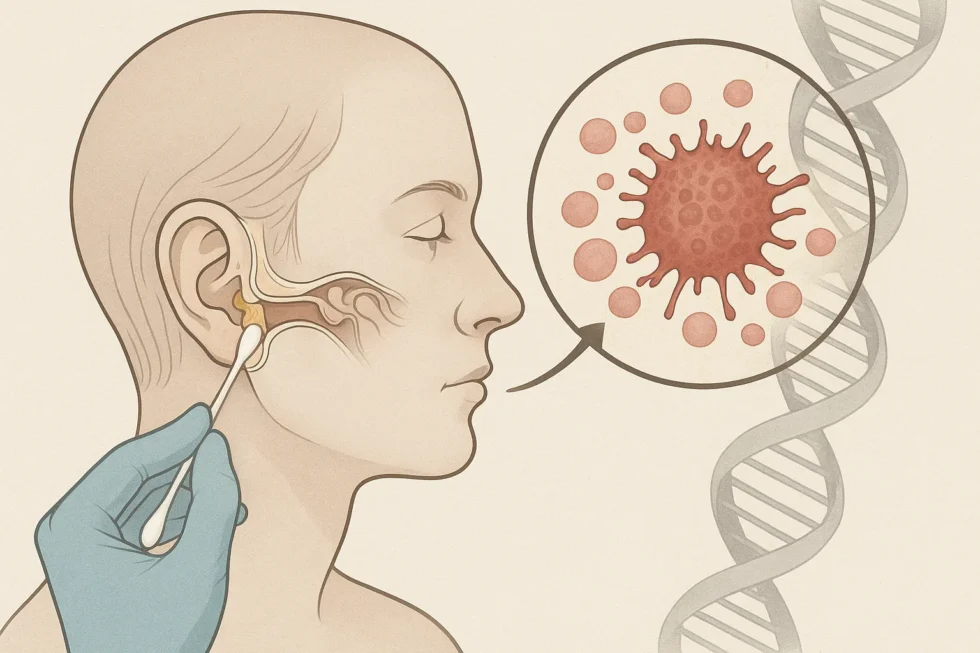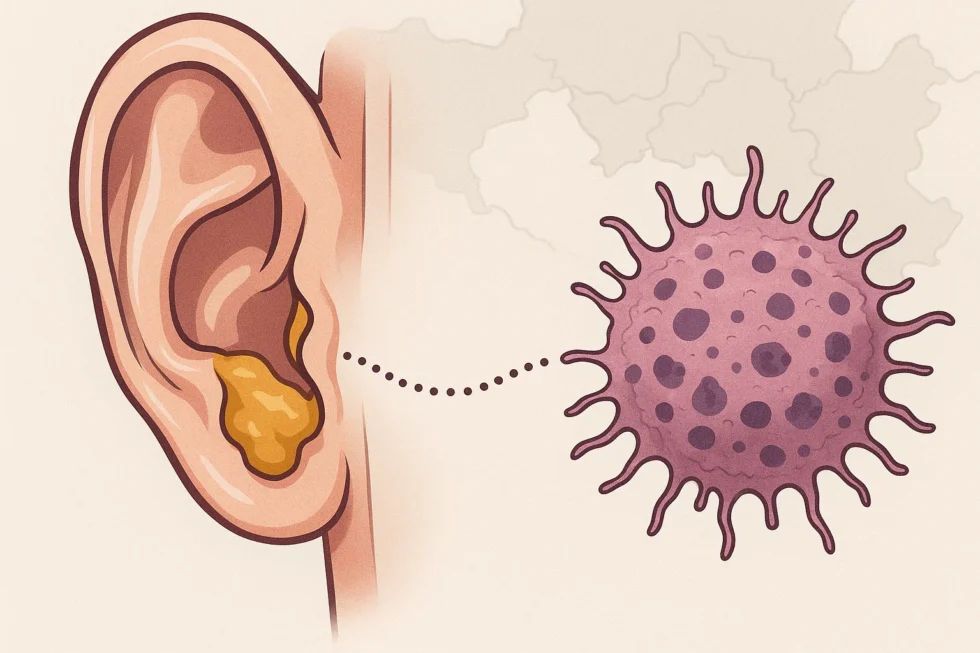What earwax reveals about cancer: scientists map disease clues in the body’s “hidden archive”

Fatigue, unexplained weight loss, or chronic inflammation — these early warning signs often appear long before a serious disease is diagnosed. Yet conventional blood or urine tests can miss long-term biochemical changes that develop silently over weeks or months. That gap has driven scientists to look at an unexpected diagnostic source: earwax.
In August 2019, a team led by Prof. Nelson Roberto Antoniosi Filho at the Federal University of Goiás (Brazil)published one of the first scientific analyses of earwax (cerumen) as a diagnostic material in Scientific Reports (Nature Publishing Group). Using gas chromatography–mass spectrometry, the researchers identified 27 characteristic metabolites that clearly separated cancer patients from healthy volunteers. The study demonstrated that earwax stores metabolic information for months — far longer than blood or urine — making it a potential long-term biochemical archive.
According to NewsToday24, research institutions in Germany and across Europe are following this approach with growing interest. Several German and UK universities are already discussing pilot projects to evaluate whether cerumen-based metabolic screening could one day supplement standard laboratory diagnostics. While the method remains experimental, medical experts consider it a promising step toward non-invasive, affordable, and preventive health monitoring — not as a replacement, but as a complement to existing tests.

How a future earwax test would work
- Collection: A sterile foam or cotton swab gathers cerumen from the outer canal (no deep insertion).
- Stabilization: The swab goes into a sealed tube; earwax stays stable at room temp for days to weeks.
- Analysis: Mass spectrometry (LC-MS/GC-MS) or infrared spectroscopy reads lipid, steroid, amino-acid and oxidative-stress markers.
- Signal: Pattern-recognition models compare your profile to reference ranges to flag “atypical” clusters associated with certain diseases.
- Action: Abnormal results do not diagnose cancer; they trigger standard confirmatory tests (bloods, imaging, biopsy if indicated).
What might be detectable (and what that really means)
- Cancer: Lipid peroxidation products, altered steroids, inflammatory metabolites that correlate with tumor-driven metabolic stress.
- Diabetes / insulin resistance: Advanced glycation by-products, shifted fatty-acid ratios reflecting glucose dysregulation.
- Alzheimer’s / Parkinson’s: Oxidative-stress markers and lipid changes linked to neuroinflammation (supportive, not definitive).
- Chronic stress / depression: Cortisol and related steroids can accumulate in cerumen, acting as a longer window than saliva.
Important: these are risk signals, not diagnoses. Any positive screen should be followed by guideline-based medical evaluation.
Benefits vs. limits (be realistic)
Pros
- Noninvasive, quick, painless
- Long look-back window (weeks–months)
- Potentially lower cost than imaging
- Works even when short-term labs look “normal”
Limits
- Small study sizes so far
- No universal reference ranges yet
- False positives/negatives are possible
- Always needs confirmation with standard tests
Practical tips: ear care & safe self-sampling
- Do not dig deep. Only sample the outer ear canal entrance. Never use rigid objects.
- Choose the right swab. Use sterile, single-use foam/cotton swabs; avoid scented or lotion-coated tips.
- Skip drops 48 h before sampling. Oils/cerumenolytics dilute biomarkers.
- No sampling with symptoms. Pain, discharge, fever, sudden hearing loss = see a clinician first.
- Storage: If sending a sample, keep sealed at room temperature, away from heat/sunlight.
- Cleaning routine: If you produce a lot of wax, ask an ENT about microsuction—safer than cotton-bud “deep cleaning.”
Who might benefit first
- People with persistent, unexplained symptoms despite normal routine labs.
- Those with family history of cancer, diabetes, or neurodegenerative disease.
- Long-COVID or chronic-fatigue patients tracking inflammatory load.
- Individuals needing a low-burden, periodic check between annual exams.
Red flags that need medical care now (don’t wait for any earwax test)
- Unintentional weight loss, night sweats, persistent fever
- New lumps, unexplained bleeding, or pain that worsens
- Neurological changes (confusion, weakness, severe headaches)
- Rapidly changing moles or skin lesions
How earwax compares to other samples
| Feature | Earwax (cerumen) | Blood | Urine | Saliva |
|---|---|---|---|---|
| Window | Weeks–months | Hours–days | Hours–days | Minutes–hours |
| Invasiveness | Very low | Needle draw | Very low | Very low |
| Best for | Long-term metabolic stress, steroids, lipids | Precise clinical quant | Kidney/glucose screening | Cortisol, some hormones |
| Key caveat | Reference ranges still emerging | Short window, clinic visit | Hydration dependent | Rapid fluctuation, contamination |
Smart next steps (if/when pilots open)
- Join early-access programs. Keep an eye on university hospitals or biotech startups running cerumen biomarkerstudies — especially in the UK, Germany, and the US. Many offer free sampling kits to volunteers.
- Start your own baseline. Even before official tests hit the market, note your diet, stress level, medication, and exercise patterns. These factors influence metabolic residues in earwax and help interpret future data.
- Combine with wearables. Link earwax analysis to continuous trackers for sleep, heart rate variability, or stress load — this creates a full picture of your metabolic rhythm.
- Repeat regularly. The power of cerumen testing lies in comparison over time. Run it every 6–12 months rather than once, similar to blood panels.
- Store samples properly. If you’re part of a trial, ensure samples are sealed, dated, and kept at room temperature. Avoid contamination with creams or ear drops.
- Ask about data security. Before sharing biomarker data, check the lab’s GDPR compliance and anonymization practices.
- Keep your doctor involved. Treat earwax results as early signals, not final verdicts. Always confirm findings with medical professionals before taking action.
- Stay informed. Follow verified science outlets or health-tech sections on platforms like NewsToday24, Nature Health or ScienceDaily — they often report pilot updates and regulatory milestones first.
- Think prevention, not fear. Use potential insights for lifestyle adjustments — better sleep, nutrition, and regular checkups — instead of self-diagnosis.
- Be patient. Large-scale validation takes years. But as sensors shrink and molecular analytics become cheaper, your next annual check-up might include an earwax scan.
Stay connected for news that works — timely, factual, and free from opinion — and insights that matter now: Berlin, Ukraine, and the world: Amazon War Film Achieved What No German Movie Did – Streaming Release Confirmed





